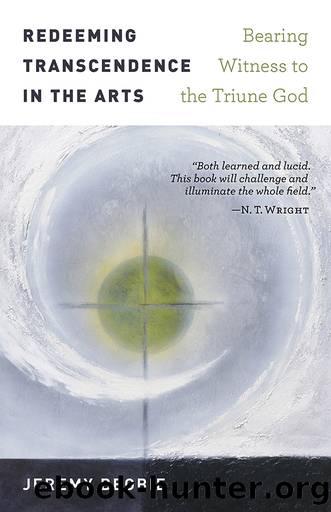Redeeming Transcendence in the Arts by Jeremy Begbie

Author:Jeremy Begbie
Language: eng
Format: epub
Publisher: Eerdmans
1. I owe the phrase to a conversation with Rowan Williams. See C. Kavin Rowe, âBiblical Pressure and Trinitarian Hermeneutics,â Pro Ecclesia 9, no. 3 (2002): 295â312.
2. The phrase comes from David Yeago; see David S. Yeago, âThe New Testament and the Nicene Dogma: A Contribution to the Recovery of Theological Exegesis,â in The Theological Interpretation of Scripture: Classic and Contemporary Readings, ed. Stephen E. Fowl (Cambridge: Blackwell, 1997), 88. On the kind of âscriptural imaginationâ I am seeking to employ here, see the succinct treatment by C. Kavin Rowe, âThe Formation of Scriptural Imagination,â Faith and Leadership, June 17, 2013, https://www.faithandleadership.com/features/articles/c-kavin-rowe-the-formation-scriptural-imagination.
3. From Gerard Manley Hopkins, âGodâs Grandeur,â in Poems and Prose (London: Penguin Classics, 1953), 27.
4. Unless otherwise indicated, all Scripture references come from the New International Version.
5. Thomas Aquinas, Summa Theologiae I, q. III, art. 5.
6. For a particularly lucid discussion, see Ian A. McFarland, From Nothing: A Theology of Creation (Louisville: Westminster John Knox, 2014).
7. Catherine Keller, Face of the Deep: A Theology of Becoming (London: Routledge, 2003), 16. In the late modern climate, âThe ex nihilo tradition has been linked to patterns of exploitation, domination and colonialism as if the world was an artefact produced for consumption. As a web of intricately related living forms, however, the creation is better described, it is claimed, by a theology that offers more organic models of the God-world relationship. So immanence and indwelling tend to replace traditional themes of transcendence and otherness, while resources from other faiths are readily deployed.â David Fergusson, âKarl Barthâs Doctrine of Creation: Church-Bells beyond the Stars,â International Journal of Systematic Theology 18, no. 4 (2016): 414â31, here 416.
8. Here, âwithâ (pros) means something akin to âpresent toâ or âin the presence of.â
9. It may be that the Jewish wisdom tradition is operative here, where Wisdom is pictured as the âmaster workerâ alongside God in the creation of the world. See Marianne Meye Thompson, The God of the Gospel of John (Grand Rapids: Eerdmans, 2001), 136; Richard B. Hays, Echoes of Scripture in the Gospels (Waco: Baylor University Press, 2016), 308â10.
10. In Johnâs prologue, Jesus is described as monogenÄs (1:14, 18). Although this has often been translated as âonly-begotten,â scholars generally agree that the term is best understood as meaning âone and only,â or âunique.â Because the word was often used of a child, and because of the mention of âFatherâ in this context, Richard Bauckham believes it is reasonable to translate it as âGod the only Son.â See Richard Bauckham, âThe Trinity and the Gospel of John,â in The Essential Trinity: New Testament Foundations and Practical Relevance, ed. Brandon Crowe and Carl R. Trueman (London: Apollos, 2016), 83â106, here 88â89.
11. See, e.g., John 3:35; 5:20; 10:17; 15:9â10; 17:23â24, 26.
12. Bauckham, âThe Trinity,â 102.
13. Richard Bauckham, âRevelatory Word or Beloved Son? Barth on the Johannine Prologue,â in Reading the Gospels with Karl Barth, ed. Daniel L. Migliore (Grand Rapids: Eerdmans, 2017). I am deeply indebted to Richard Bauckhamâs writings in the first part of this chapter.
Download
This site does not store any files on its server. We only index and link to content provided by other sites. Please contact the content providers to delete copyright contents if any and email us, we'll remove relevant links or contents immediately.
More Language of Letting Go: 366 New Daily Meditations by Melody Beattie(2851)
The Holy Spirit by Billy Graham(2779)
The Secret Power of Speaking God's Word by Joyce Meyer(2755)
To Light a Sacred Flame by Silver RavenWolf(2680)
Tuesdays With Morrie by Mitch Albom(2578)
The Lost Art of Good Conversation by Sakyong Mipham(2443)
The Traveler's Gift by Andy Andrews(2304)
Kundalini by Gopi Krishna(2094)
A Kingsbury Collection by Karen Kingsbury(2010)
Finding Chika by Mitch Albom(1885)
Angels of God: The Bible, the Church and the Heavenly Hosts by Mike Aquilina(1870)
Angels by Billy Graham(1844)
As a Man Thinketh by James Allen(1821)
Curse Tablets and Binding Spells from the Ancient World by Gager John G.;(1769)
The Yoga of Jesus: Understanding the Hidden Teachings of the Gospels by Paramahansa Yogananda(1752)
Autobiography of a Yogi (Complete Edition) by Yogananda Paramahansa(1739)
Barking to the Choir by Gregory Boyle(1731)
Anxious for Nothing by Max Lucado(1726)
How To Be Born Again by Billy Graham(1670)
